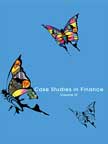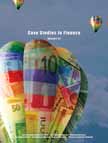Analyzing the Risk Weighted Performance of Equity Mutual Funds
|
|
ICMR HOME | Case Studies Collection
Case Details:
Case Code : FINC058
Case Length : 27 Pages
Period : 1994-2008
Pub. Date : 2009
Teaching Note :Not Available
Organization : Morgan Stanley / IDFC / Taurus / DSPML Tiger / SBI Mutual Fund
Industry : Financial Services / Mutual Funds
Countries : India
To download Analyzing the Risk Weighted Performance of Equity Mutual Funds case study (Case Code:
FINC058) click on the button below, and select the case from the list of available cases:


Price:
For delivery in electronic format: Rs. 400;
For delivery through courier (within India): Rs. 400 + Rs. 25 for Shipping &
Handling Charges
» Finance Case
Studies
» Short Case Studies
» View Detailed Pricing Info
» How To Order This Case
» Business Case Studies
» Area Specific Case Studies
» Industry Wise Case Studies
» Company Wise Case Studies
Please note:
This case study was compiled from published sources, and is intended to be used as a basis for class discussion. It is not intended to illustrate either effective or ineffective handling of a management situation. Nor is it a primary information source.
Chat with us

Please leave your feedback

|
|




<< Previous
Excerpts
Comparison with IDFC Enterprise Equity Fund, Taurus Star Share Fund and BSE 200
|
In this section, we are comparing MSGF with IDFC Enterprise Equity fund (IDFC fund), Taurus Star Share fund (Taurus fund), and BSE 200...
Sharpe's Ratio
Sharpe's ratio evaluates the performance of a portfolio/fund based on the total
risk of the portfolio/fund. It takes standard deviation as a measure of risk.
Sharpe's ratio can be calculated by the following formula
S = (Rp - Rf)/σp
Where Rp = Return on portfolio/fund
Rf = Risk free return
σp = Standard deviation of return on the portfolio/fund...
|

|
Comparision of Performance of MSGF with Open Ended Funds
In this section, we will compare the performance of MSGF for the period between December 2004 and November 2007 with open-ended funds like Magnum Global Fund Growth (Magnum GFG), Taurus Star Share Fund (Taurus), DSPML Tiger (DSPML), and Magnum Multiplier Plus (Magnum MP). From Chart IV, it is clear that all these funds moved in tandem. However, the returns generated by them varied significantly...
Exhibits
Exhibit I: SEBI Guidelines for MSMF
Exhibit II: Risk and Return on BSE 200 and MSGF (March 1994 - September 2007)
Exhibit III: Return on BSE 200 and MSGF (September 1997 - September 2007)
Exhibit IV: Return on BSE-200 and MSGF (September 1999 - September 2007)
Exhibit V: Return on BSE-200 and MSGF for Seven Year Period (September 2000 -
September 2007)
Exhibit VI: Return on BSE 200 and MSGF for Six Year Period (September 2001 -
September 2007)
Exhibit VII: Return on BSE 200 and MSGF for Five-Year Period (September 2002 -
September 2007)
Exhibit VIII: Return on BSE 200 and MSGF for Three-Year Period
Exhibit IX: Return on BSE 200 and MSGF for Two-Year Period
Exhibit X: Return on BSE 200 and MSGF for One Year Period
Exhibit XI: Performance of MSGF in Relation with BSE 200, IDFC Enterprise Equity
Fund and Taurus Star Share Fund (June 2006 - November 2007)
Exhibit XII: Performance of MSGF in Relation with Taurus Star Share Fund, DSPML
Tiger, Magnum Multiplier Fund and Magnum Global Fund-G (December 2004 - November
2007)

|
|










